#guru 2007
Text

Nigo .
#fashion#high fashion#music#art#high end fashion#atlanta#anime#chicago#kanye west#kanye west donda#high class#guru#bape 2007#bape#nigo archive#nigo bape#nigo
8 notes
·
View notes
Text
In the year 2007, Abhishek Bachchan gave a tough competition to Shahrukh Khan-Akshay Kumar, earned 100 crores from 22 crores film
In the year 2007, Abhishek Bachchan gave a tough competition to Shahrukh Khan-Akshay Kumar, earned 100 crores from 22 crores film
Abhishek Bachchan Aishwarya Rai Movie Guru: In the year 2007 also many superhit films of Bollywood were released. At the box office, Aamir Khan, Shah Rukh Khan, Akshay Kumar, Salman Khan gave a fierce competition to each other. The list of hit films of that year…

View On WordPress
#2007 Blockbuster film#2007 super hit film#Abhishek#ABHISHEK BACHCHAN#Abhishek Bachchan Aishwarya Rai film Guru#Abhishek Bachchan blockbuster film#Abhishek Bachchan blockbuster film Guru#Abhishek Bachchan flop film#aishwarya rai#Bachchan#Bhool Bhulaiyaa#Blockbuster film Guru#Bollywood Box Office Collection#Chak De IndiaChak De India#competition#crores#Directed by Mani Ratnam#earned#film#gave#guru box office#guru box office collection#Guru box office collection in 2007#guru clash#Guru Director#guru hit or flop#Guru News 18#guru songs#guru story#Hey baby
1 note
·
View note
Text


Aishwarya Rai in Guru (2007)
101 notes
·
View notes
Text
Interview with Nakayama Hisashi, former member of Hikari no Wa (Aum Shinrikyo branch)
cw: cults, domestic violence, sexual manipulation, conspiracy theories, verbal abuse
Do not harass anyone mentioned here. I'm only citing Mr. Nakayama's name and website because he let me do so.
Do not tag as true crime
Originally posted on Reddit by me
Matryoshka dolls are a well-known symbol of Russian arts and crafts; a majestic doll that, by the hands of others, is forced to reveal itself smaller and smaller until, finally, its tiny, hollow interior becomes visible.
Though they have dozens of tales attached to their creation and meaning, none of it is grounded on reality: these dolls were invented pretty recently with fully comercial purposes. Matryoshka aren't exactly meaningful for their land's mythology, nor original. But at least they're cute and saleable.
So is Fumihiro Joyu, ex-spokesman and executive of Aum Shinrikyo.
Joyu is the kind of person who will never run out of stories to tell about; graduated from Waseda University, one of Japan's most prestigious institutes to this day, he quickly lost interest on the labour market and used his knowledges in a new, weird yoga classroom, which would later become the infamous Aum Shinrikyo. And Aum surely got Joyu busy; he served as a spokesman, public relations representative, head of Aum's russian branch and almost as one of its men of action: in 1993, he attempted to spread anthrax in Kameido, Tokyo. It failed miserably.
But he only became infamous in 1995, when he defended the cult against allegations that they were responsible for the subway sarin attack at all costs. His devotion didn't earn him any prestige, just a lot of fans willing to steal and auction off his dirty socks and a saying attached to his name: ああいえば上祐 (Aa ie ba Joyu, which roughly translates to "If you say so, Joyu"). After being sentenced to three years of prison in late 1995 due to charges of perjury and forgery of private documents, he declared that "Master Asahara is a guide, a savior, and everything to me". It seemed unlikely that his adoration would be shaken.
But after being released from prison in 1999, it seemed that Joyu had a change of heart. He didn't leave Aum (in fact, Joyu became its De Facto representative under the name Aleph), but tried to reform it, reflect on its multiple incidents and eliminate Asahara Shoko's influence. In 2007, after a series of conflicts with Asahara's wife, children, and other executives, Joyu announced he was going to leave Aleph and launch a new organization: Hikari no Wa. According to its website:
Hikari no Wa is not a religion. This is a classroom where you can learn the wisdom and philosophy of happiness from the East and the West, including Buddhist thoughts, meditation methods, and modern psychology, without believing in a specific guru, god, or sect.
The classroom, of course, was met with protests and doubts. The U.S Department of State only lifted its designation as a terrorist foreign organization (TFO) as late as 2022, and Japanese police still surveils it.
Since then, despite still being considered a controversial figure, Joyu has made attempts to clear his image; according to Hikari no Wa's website, the classroom pays compensation to the victims of the subway sarin attack, deprogramms Aleph believers and apologises for its representative's former criminal activities. Joyu also seems to have invested in unusual methods of self-promotion, such as taking part in a hiphop EP where he sings while an edit of the 1995 subway attack plays in the background. He also published a book on how to identify dangerous cults despite his status as a potential cult leader.
There is very little information about Hikari no Wa in English. Its only known activities are events and speeches about spirituality held by Joyu himself, its alleged "Aum liquidation" and its "Pilgrimage to Sacred Places".
However, around February 2024, I stumbled upon a fairly obscure site: stop-hikarinowa.com. According to itself, its purpose is to:
Ask Hikari no Wa to disband.
Promote the exchange of information and people-to-people exchanges on the issue of Hikari no Wa.
Provide support for Hikari no Wa members to withdraw from membership.
Disseminate information to society about the problems of Hikari no Wa.
In addition, we will carry out all activities that we deem necessary for issues related to Hikari no Wa and Aum Shinrikyo.
It also claims Hikari no Wa is, in fact, a cult:
Just like Asahara in Aum Shinrikyo, I think it boils down to the fact that Joyu is in control of everything in Hikari no Wa.
It's true that Hikari no Wa changed its doctrine because it wanted to get rid of probation, and it also said that it was a philosophy and thought class.
All of the reforms that have been carried out over the past 10 years have been carried out at the discretion of Joyu. This fact proves that it is possible to return to the doctrines and operations of the past with the sole intention of Joyu.
As long as he's under inspection, he can't do anything as crazy as Aum (and this is the same for Aleph), but if it were to be removed, no one would be able to stop him from running wild like he did with Aum.
The guru becoming a dictator is common to other cults, but if a cult that has crossed the line in the past is allowed to go unchecked, it will be a different danger than other cults.
The danger of Hikari no Wa varies greatly depending on what happens to the government's surveillance, but at least it seems that it is an organization that cannot guarantee even safety without national surveillance.
* On "Frequently Asked Questions"
I contacted its representative, Nakayama Hisashi who's both a former Aum believer (from 1996 to 2007) and a Hikari no Wa one (from 2007 to 2016) and managed to interview him on March 30, 2024.
The interview go as follows:
Q: Tell us about yourself. You joined Aum to find out more about its practices, but what made you stay for such a long time?
A: It was cosy. Aum believers are serious and selfless, so it was really healing to talk to such people.
Q: From what I have read, despite precarious living conditions, including poor diet and cockroach-infested flats, Aum believers formed a strong sense of community. What was daily life like when you joined the organisation?
A: Food was considered a bother, and the idea was that it was good if you could get the minimum amount of energy. Even cockroaches were souls that were trying their best to live, and we looked after them with compassion. Such different values from the world were fresh and a strong sense of community existed. It was a similar life in Aum and in Aleph. In Hikari no Wa we secularised, so the ordained people remained Aum, but they disliked the filthy environment.
Q: When did you first come into contact with Joyu? What was your first impression of him?
A: Around 2005. My first impression was that he was a hard-working practitioner.
Q: Were you aware that he was at odds with the Asahara family? Were there any tensions within Aum in the late 2000s?
A: Initially I did not know that there was a conflict. Inside Aum, the explanation was that Joyu was in training, so I didn't think there was a conflict. Believers like me were not informed of anything. When Joyu came out of prison and the Group Regulation Law was passed, believers though Aum was going to be destroyed, so there was a sense of tension, and although there were people who opposed Joyu's methods, none of us thought that there would be a split later on.
Q: When Hikari no Wa was formed in 2007, why did you join it instead of staying with Aleph? What convinced you?
A: Because they sympathised with the idea of social reconciliation by acknowledging the incident. And I was banned from Aleph for having contact with Joyu.
Q: What were the first days of Hikari no Wa like? I have seen a video from around 2009[1], and it seems that many people protested its existence.
A: Hikari no Wa was not trusted at all, even if they said they were reflecting on Aum. I thought that if I reflected sincerely, society would one day understand me. Perhaps it was only the believers who were deceived by Joyu's words that he had reflected on his life.
Q: What was your daily life like? Did you go to work or interact with normal society? Did you talk to family and friends?
A: I moved from one job to another and worked on construction sites for a long time. I told my family about it, but my wife was vehemently against it, so I didn't talk much about being a believer. Once I mentioned that I was a member at work, but I was discriminated against so quit my job. Since then, I stopped talking about Hikari no Wa to my friends. But I did have normal social interactions outside of the classroom.
Q: I assume you are familiar with the B.I.T.E model, which lists cult behaviour. Let's use it to ask some questions. To what extent was your personal life regulated by Hikari no Wa? Was your diet, social or sex life regulated by the cult, or did you need permission to make major decisions?
A: I was a noisy believer [laughs], so I was never dominated by the cult. But they were giving detailed instructions to other people on how to spend their money. I would immediately announce it on social media, so I guess the cult was also cautious. It seems that I was treated differently from the others.
Q: I watched some videos from Hikari no Wa's Youtube channel[2] and they seem to travel frequently. At the same time, they pay compensation to Aum victims. I wonder if a tremendous amount of money is being taken from its believers, or if Joyu is making money in other ways.
A: The pilgrimages are a means of collecting large sums of money from believers. Devotees are desperate to join in (laughs). "Why is it so expensive?" I asked him, and he excused himself by saying, "Because I'm compensating them". Compensation is the excuse for the high participation fees. But we couldn't operate on that alone, so some of our staff went out to work, and I think we took a lot of money from the rich and quiet believers.
Q: Hikari no Wa page claims to be a place to learn psychology and natural doctrine, without any religious elements. Is this true? Joyu is not licensed to talk about psychology, and he seems to be getting increasedly incoherent.
A: I was confused too. In the classroom, I was reading sutras and doing zazen[3]. And then they said, "It's not a religion", so I thought they were deceiving the world. I think that Joyu himself probably doesn't know what he is doing anymore (laughs).
Q: I saw you accuse Joyu of still being an Aum believer and simply hiding Asahara. Can you elaborate on that?
A: When I left Aleph, Joyu said to me: 'I will surely share my reincarnation with the Venerable Master (Asahara). So if you follow me, you will surely meet the Venerable Master again." In other words, following Joyu means that no matter how much you deny Asahara, you are recognised in the doctrine of Aum. Joyu still does not deny reincarnation; if there is reincarnation, then Joyu and Asahara will meet again, and people who are closely related to Joyu will meet Asahara again. The only way to deny this is to deny reincarnation or to dissolve the organisation and live modestly. Because of this idea, everything that Joyu says and does to get people to recognise him is to hide Asahara. There's no retraction or apology to his followers for what he said at that time. I don't think he is remorseful at all.
Q: Wait, that's big! Do you have evidence?
A: It was just my experience because it was in a private conversation. I've told the public security authorities and I also think it's evidence for the renewal of my observation, but it's just my testimony, I don't think it's evidence.
Q: That is unfortunate, but I still think it stands out. From reading various discussions of yours, it seems that there is sexual manipulation going on within Hikari no Wa. Can you tell us a bit more about it?" I saw terms such as "sexy business".
A: It's a technique known in Japan as 'shirokoi business'. In Aum, love was also an affliction, but having romantic feelings for the Venerable Master (Asahara) was considered a good thing. Intense romantic feelings of wanting to be recognised by the Master and to keep him to oneself were considered to be a form of faith. Joyu frequently appeared in the media during the Aum Affair, which gave rise to a group of fans called "Joyu Gals". Such Joyu fans started coming to Hikari no Wa. Not only 90s Joyu fans, but also new fans are still coming to Hikari no Wa through YouTube and events. They are taking money by cleverly utilising such fan psychology and romantic feelings. The method is to stimulate women's romantic feelings and dominate them by saying, for example, "I have a connection with you from the past". In Japan, there are 'host clubs' where men entertain women, and the sales method is similar to this. Although there was only one victim, I was consulted by a victim who said she actually had sexual relations with Joyu. But at the strong request of the victim, we don't really take it up.
Q: I have also read that Joyu is prone to domestic violence, please elaborate on this.
A: Joyu has a strong desire for control, so he would yell at staff and others when he didn't like something, and sometimes beat them up. When I asked someone who was actually hit, he said that he had his karma taken away (laughs). I think this is a typical example of Aum thinking, which is pro-violence. I criticised him a lot, so I don't think he does violence now, but I think he still uses words to corner his opponents. Joyu has a male-dominated mindset, so his desire for domination over women is particularly strong, and I think it tends to lead to violence.
Q: Have you witnessed physical or verbal violence? or have you been subjected to violence? Again, there is no intention to invade your privacy. If you do not wish to answer, you do not have to.
A: I have never been hit directly. However, when I quit, I was verbally abused. I saw him shouting at staff on many occasions. Old believers know this all too well. He didn't have any anger control at all (laughs).
Q: Why did you start to leave Hikari no Wa? Did other members also quit?
A: I loved Hikari no Wa, not Joyu, so I wanted society to be a comfortable and secure place for the followers who gathered there. In reality, however, the believers were only paying money and being used. I wanted to reform that, but I couldn't do it and was forced to quit. I was also exhausted, so it was probably just as well. There were more than 100 staff members at the time of the Aleph Joyu Faction, but by the time Hikari no Wa was established, there were only about 60, and now there are less than 10. Those who had survived Aum and Aleph gave up on the Joyu and quit. Originally, Aum was a cult with two sides of the same coin, and only those close to them would have known the true nature of the guru, but as it became smaller and smaller, I think the number one reason is that the true nature of Joyu could not be hidden and came to the surface (laughs). The same is true of Aleph, as the closer to Asahara you were, the less you remain in Aleph. The only people left in Aleph now are people who don't know Asahara directly. The same is true of Hikari no Wa, who fled as they learnt about Joyu's character. People who found out that he was the king of the naked left. Conversely, the staff who remain now are people who don't want to admit that Joyu is naked, so they may no longer run away. It's pitiful.
It's important to note that, in July 11th 2018, it was revealed Joyu witnessed the murder of a female believer[4] back in 1991, though he didn't say anything until he could no longer be charged for it, and he still avoids this topic. Nakayama says:
After I left, it was revealed after Asahara's execution that Joyu had left female followers to die during his Aum days and had been covering it up for a long time.
When I found out about the incident, all the slight remaining feelings I had for Joyu were gone.
I thought that everything I had been working on with hope, saying that I would reflect on the incident, was a lie. I now seriously hope that the cult will be disbanded.
Moving on.
Q: Sorry to digress, but I was very interested in Hikari no Wa's instance on science. Joyu often talks about psychology, even if he's not licensed to talk about it. And he apparently gathered at events without masks during the pandemic.
A: Right. What the Joyu says publicly, he says it with an awareness of what society will think of him. He pretends to be a sensible person. But in his true feelings, he thinks completely differently, and what he says and what he does are completely different. If you look at what he does, not what he says, you can see what he really thinks.
Q: Sorry to be too straightforward, but is Joyu a conspiracy theorist? I'm not talking about extreme and flash cases like Qanon. It's about things like "this disease can be cured with X, Y and W"
A: He has not been vaccinated. This may be because he believes that vaccines are not desirable from a parrot doctrinal point of view and that if he practices, he will not get infected. I don't want to call it a conspiracy theory, but I think he thinks that practising is a better way to fight infection than vaccines or medicine.
Q: That's bad. Do believers have the freedom or critical skills to get themselves vaccinated?
A: It might be different for different people. Maybe many people think the same way as Joyu. That is, that practice is more effective than medical treatment. If Joyu would be asked by his followers, he would not deny the vaccine, but he would not dare to recommend it either. Since many people are dependent, I think many of them would not take the vaccine themselves if Joyu had not taken it.
Q: Sorry to change the subject again, but there is one more thing I wanted to know. I browsed through some of the accounts and posts and found screenshots of Joyu himself talking about and endorsing Vajrayana[5]. One of them was yours[6]. Is it authentic?
A: I always think about the risk of a court case when I send out screenshots, so I don't fake it. Hikari no Wa always say it'll go to court and then ask me to delete it.
And, then, the interview ended. I had more to ask, but it was 3 AM and I didn't want to waste more of Mr. Nakayama's time.
It's important to note that all of this is simply alleged and I'm solely giving voice to a former member. Joyu has still a large platform, with around 17k followers on Twitter, and appears on documentaries and interviews as an cult expert of some sorts. It's not uncommon for former cult members to study about it later on, but Joyu didn't go through any deprogramming initiative, not even during his time in prison. And, of course, it's certainly unusual for an ex-believer to establish a "non religious' (though with holy pilgrimages) and "non guru centered" (though he's the only member with an online presence) organization.
Do not track and harass former Aum/Hikari no Wa members. Mr. Nakayama gave me permission to say his actual name and site, but this experience has been traumatic to many people.
During my research, I found a quote associated with Joyu in some foruns and websites, but couldn't find any proof it was actually his nor the context in which it was supposedly said.
A snake that doesn't shed its skin will die
Matryoshka are self aware, I guess.
13 notes
·
View notes
Note
Hi I just wanted to say I absolutely love that you are talking about Viggo and Orlando. I just recently fell a bit into the rabbit hole because I adore Viggo and watching how him and Orlando became so close fascinates me so much. It’s crazy filling in the mysterious pieces because only 2 people really know what went on during that crazy time of their lives. I really hope you keep talking about them more because it’s such a lovely love they have for each other. Have a nice day! (:
All the years that have passed makes that rabbit hole pretty damn deep, eh? I thought I was just peeking, but I fell down and can't get out...
Well, Viggo is in his own right a deeply fascinating human, so one can dwell there for quite some time. One thing that I find particularly charming is that his creativity, his "artist-ness" doesn't seem to equal pretentiousness (although, I'm sure it can be interpreted that way). He has a very calm self-assuredness about him, which I think people around him find very reassuring. And for Orlando, it must have been such a blessing (even if, like he's said himself, he didn't fully appreciate it at the time, being so young) to have Viggo be the center of his world, those months and years in NZ, on his first big job. It's hard not to find it touching how they bonded, despite the age difference. When Orlando has mentioned this, they seem to have been talking a lot. In my mind, Orlando is like a disciple to his guru, Viggo the benevolent king of his heart.
What happened between them, on set and after is indeed shrouded in an enchanting vail of mystery. And what happened sometime after 2007? Why did they lose touch? Did Hollywood lure Orlando away? Was Viggo too difficult to pin down? Or did their paths just diverge too much?
A particularly appealing fantasy how you can imagine Viggo created some of his art and poetry with Orlando in mind. It's such a romantic notion. And those poems are quite romantic too, angsty, mysterious and beautiful. It's easy to imagine Viggo being inspired by his devoted, and oh-so pretty disciple out and about in the breathtaking wilderness of NZ.

(Took this ask and ran with it. Seems I have still more to say... I've been reading too much fanfiction. Living in pure fantasy world.)
6 notes
·
View notes
Text
Round 2A: Veronica Mars vs Batwoman


Veronica Mars: As the daughter of well-respected County Sheriff Keith Mars, Veronica's biggest life problem was getting dumped by her boyfriend, Duncan Kane, until the murder of her best friend, Lilly Kane. After Lilly's murder, Veronica's life falls apart. Keith mistakenly accused Lilly's father, popular software billionaire Jake Kane, of involvement. When Mr. Kane is proven to be innocent, he has Keith ousted as sheriff in a recall election, who the corrupt Don Lamb then replaces. Veronica's mother, Lianne, develops a drinking problem and leaves town, never to return. Veronica's "09er" friends—wealthy students from the fictional 90909 ZIP Code—demand that she choose between them and her father; Veronica chooses her father. After losing the election for sheriff and ostracized by the entire community, Keith opens a private investigation agency, Mars Investigations, where Veronica works part-time. Veronica helps her father solve cases and conducts her investigations on behalf of schoolmates.
Batwoman: Three years after Batman mysteriously disappeared, Gotham is a city in despair, and it's under the watch of Jacob Kane and his military-grade Crows Private Security, which now protects the city with omnipresent firepower and militia. When the Alice in Wonderland gang targets the firm, Kane's daughter Kate returns home, deciding that if she wants to help her family and her city, she'll have to become the one thing her father loathes -- a dark knight vigilante. With the help of her stepsister Mary and the crafty Luke Fox, the son of Wayne Enterprises' tech guru Lucius Fox, Kate Kane continues the legacy of her missing cousin, Bruce Wayne. Armed with a passion for social justice and a flair for speaking her mind, Kate soars through the shadowed streets of Gotham as Batwoman.
#veronica mars#batwoman#bracket tournament#bracket#tournament#bracket battle#the cw#tv shows#battle#cw shows#showdown#polls
11 notes
·
View notes
Text
Now Watching: The Saw Cinematic Universe!
This is one of my favorite cinematic universes. I have always loved these movies. Its horror, but done right. Scary for the right reasons, but not cheap jump scares. Music is great, who doesn't love Billy? I just recently watched Saw X and decided to make a post or two about it!

Saw (2004)
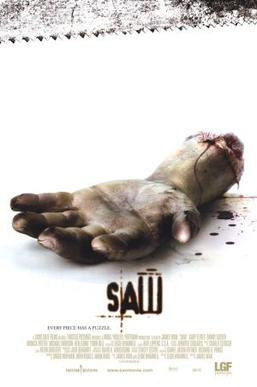
Photographer Adam Stanheight (Leigh Whannell) and oncologist Lawrence Gordon (Cary Elwes) regain consciousness while chained to pipes at either end of a filthy bathroom. As the two men realize they've been trapped by a sadistic serial killer nicknamed "Jigsaw" and must complete his perverse puzzle to live, flashbacks relate the fates of his previous victims. Meanwhile, Dr. Gordon's wife (Monica Potter) and young daughter (Makenzie Vega) are forced to watch his torture via closed-circuit video.
Saw II (2005)
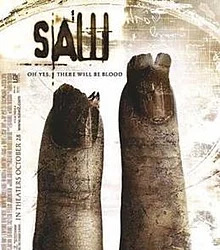
On the hunt for the twisted vigilante and serial killer Jigsaw (Tobin Bell), Detective Eric Matthews (Donnie Wahlberg) and his team must apprehend the elusive murderer to rescue eight people trapped in an abandoned house, before they succumb to his torturous and murderous games. One twist to this task is that Matthews' own son, Daniel (Erik Knudsen), is among the eight people Jigsaw has chosen to test for their lack of morality. With nerve gas pumping through the house, every second counts.
Saw III (2006)
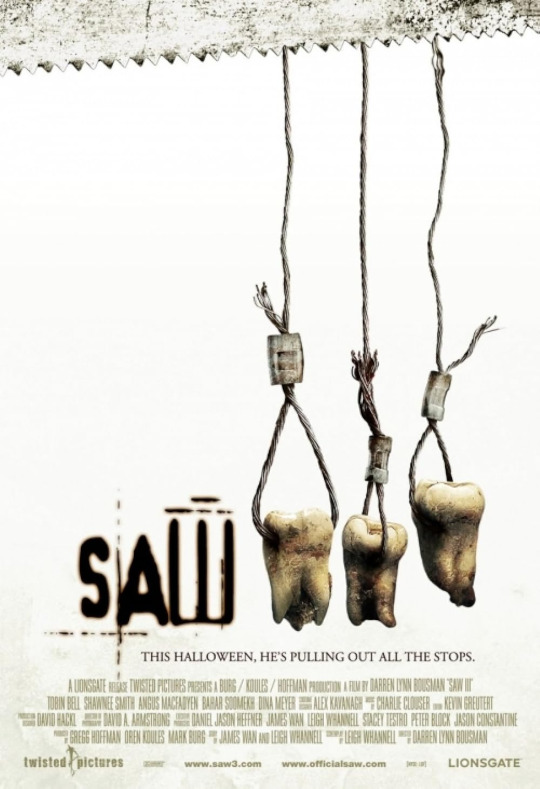
Dr. Lynn Denlon (Bahar Soomekh) becomes a pawn in the Jigsaw Killer's (Tobin Bell) latest gory game. Kidnapped and taken to an abandoned warehouse, she finds Jigsaw bedridden and dying. Her task is to keep the maniac alive long enough for Jeff (Angus Macfadyen), a fellow victim, to complete his own task. Each is unaware that Jigsaw has much bigger -- and deadlier -- plans in store.
Saw IV (2007)
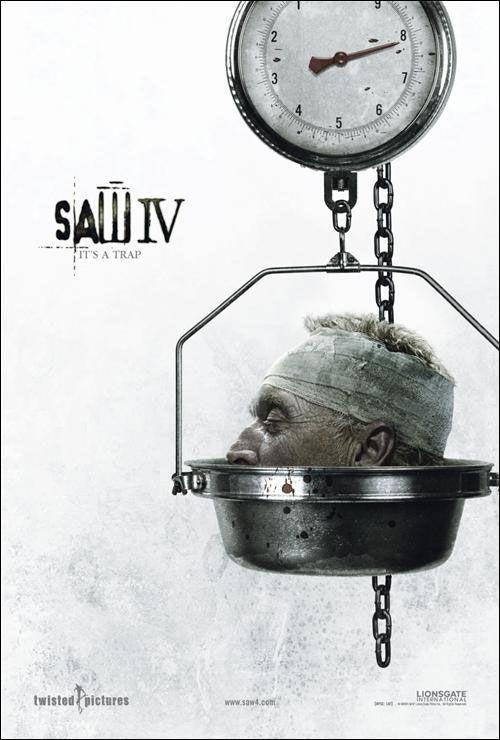
During the autopsy of serial killer Jigsaw (Tobin Bell), a cassette tape is discovered in his stomach in which he warns that his gory games will continue. Sure enough, SWAT Lt. Daniel Rigg (Lyriq Bent) is forced to follow a blood-drenched trail of torture, dismemberment and death in order to find two missing colleagues. A pair of FBI profilers follow Riggs, suspecting he might be Jigsaw's accomplice, even as they unlock the puzzle of the killer's origins, seen in gruesome flashbacks.
Saw V (2008)

Despite the fact that fiendish serial killer Jigsaw is dead, his work lives on through a new apprentice, Lieutenant Mark Hoffman, a cop who appeared to be hot on the murderer's trail. As fellow lawman Agent Peter Strahm begins to suspect Hoffman is Jigsaw's protégé, the fledgling killer sets out to dispose of him.
Saw VI (2009)
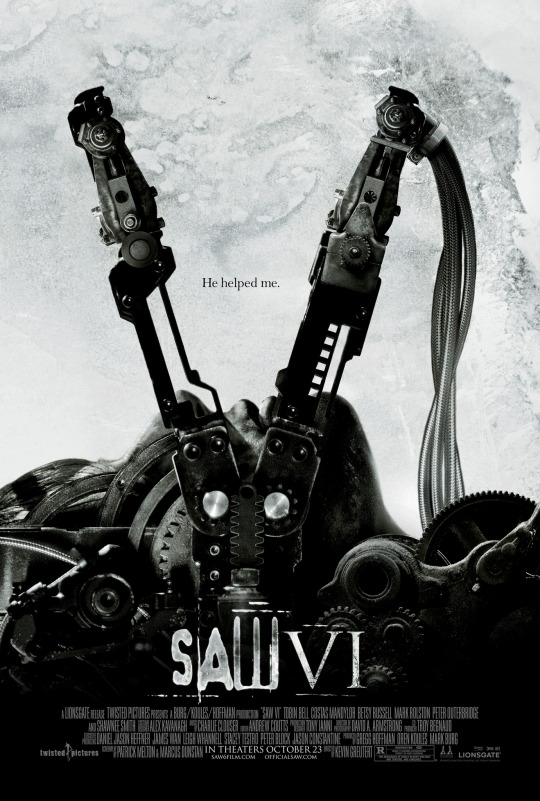
With Jigsaw (Tobin Bell) still directing events from beyond the grave, Hoffman (Costas Mandylor) emerges as the heir to the killer's twisted legacy. But as the FBI closes in, Hoffman sets in motion a game that is designed to reveal Jigsaw's grand scheme.
Saw 3D (2010)

As a fierce battle rages over Jigsaw's (Tobin Bell) terrible legacy, survivors seek support from a fellow survivor and self-help guru, who has a few dark secrets of his own. Meanwhile, crooked cop Hoffman (Costas Mandylor) seeks revenge against Jigsaw's wife and an author who has his own story.
Jigsaw (2017)

After a series of murders bearing all the markings of the Jigsaw killer, law enforcement officials find themselves chasing the ghost of a man who has been dead for over a decade, and they become embroiled in a new game that's only just begun. Is John Kramer back from the dead to remind the world to be grateful for the gift of life? Or is this a trap set by a killer with designs of his own?
Spiral (2021)
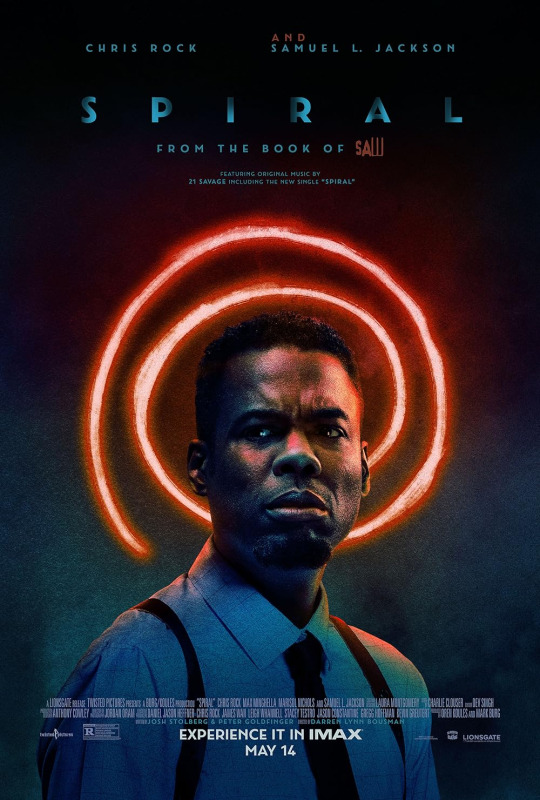
Working in the shadow of his father, Detective Ezekiel "Zeke" Banks and his rookie partner take charge of an investigation into grisly murders that are eerily reminiscent of the city's gruesome past. Unwittingly entrapped in a deepening mystery, Zeke finds himself at the center of the killer's morbid game.
Saw X (2023)

Hoping for a miraculous cure, John Kramer travels to Mexico for a risky and experimental medical procedure, only to discover the entire operation is a scam to defraud the most vulnerable. Armed with a newfound purpose, the infamous serial killer uses deranged and ingenious traps to turn the tables on the con artists.
Great series. I love this. There is no movie quite like this set, and its inspired movies since its inception. Different people have been involved in it, but it has always retained its quirks. Tobin Bell is amazing. If you have not seen any of them, look out for the chronological order post to see how to properly experience this!
#now watching#saw#cinematic universe#saw 2#saw 3#saw 4#saw 5#saw 6#saw 7#saw 8#saw 9#saw 10#horror#highly recommend#movie theatres
8 notes
·
View notes
Photo


Peter Tork’s second house (at 3615 Shady Oak Road in Studio City), as photographed in 2022 by Barry King/Alamy Stock Photo; Peter as photographed by Nurit Wilde (screenshot from Laurel Canyon: A Place In Time).
“Peter Tork’s house had belong to actor Wally Cox. It was one of those substantial homes. It had a swimming pool. It had a whole wing going off in one direction with rooms in it used for rehearsals. It had a whole pool house that had an apartment in it. A complex. Through the gate and up the driveway. And you come into this whole world there. The first time I was there it was Peter’s house, and then it became Stephen Stills’. Peter was very social. He was like a commune type of guy. A lot of people around. He was like a yoga and guru guy. In those days you could go over and could stay for a couple of days if you wanted. You’d meet somebody there and fall in love. It was a very open society.
One night I went to Peter’s house and showed slides, and Keith Moon and Pete Townshend of the Who were there. I did a slide show and they were sitting in the front, cracking jokes. Making up titles for the slides.” - Henry Diltz, Canyon of Dreams: The Magic and Music of Laurel Canyon (2009)
“[Peter] got a big house, and I went and stayed with him for a while. And then he had a big house in Studio City that I ended up buying from him. Great house. That was the CS&N house.” - Stephen Stills, Canyon of Dreams: The Magic and Music of Laurel Canyon (2009)
Peter Tork: “That house had a swimming pool that had nobody overlooking it, so we could swim au naturel. Confidential magazine actually mocked up a picture… I don’t know where they got a photo, they got a photo of the backyard of the house with the swimming pool in it, and they airbrushed in the picture of a woman of indistinct features facing the camera naked, but with her arms crossing her chest. Since I know that no woman ever did that, that’s one of the reasons I know it was a fake, and when you look closely, you can see it. Confidential magazine, which was then the hotshot gossip, tell-all National Enquirer, what Entertainment Tonight is, all that stuff, they made a point of intimating debauchery — which there wasn’t too much of. There was a lot of good stuff, a lot of innocent stuff there, too, I must say. The house was on the north side of Laurel Canyon. [..] I lived north of the canyon, really it was in the foothills of the Santa Monica Mountains there, where Laurel Canyon comes down off of Laurel Terrace, on a little tiny street called Shady Oak, I think it had one other house on it.
[…] Crosby came up to the big house a lot, along with Denny Doherty and Barry McGuire and Steve Stills […]. When I had the big house, he came up, and for a while, I vacated the big house, and Crosby, Stills, Nash and Young were staying there. The Stones stayed there for a week once, under Stephen’s aegis. He had them come over, and I think he cleared out for a week while they stayed there. That was pretty cool.
[…] Sometimes I would wake up to find them swimming in the pool with a half-empty gallon of wine floating in the pool that they would take occasional hits from. […]
Jimi came over a lot with Buddy Miles.”
[…]
Q: “Who were the women who would attend those parties at your house?”
PT: “There were a couple ladies living at my house, none of whom you would have heard of, probably. They’d gotten into the scene…one of them was a lady whose first encounter, I think, was with Chris Hillman, and whose second encounter was me, and whose third encounter was Peter Fonda, except that she got it on with Crosby on the side, because nobody cared in those days. So in a sense, it was groupies, but not the ‘pick ‘em up’ groupies on the street. These had actually evolved into ladies of position in the scene. Invaluable, really. Couldn’t carry on without them.” - Rolling Stone, 2007; published 2019
(Visitors to the house also included George Harrison and Ringo Starr; more on that in June over @harrisonarchive, for the 55th anniversary.)
“‘I don't mean to paint such a bleak picture of it [the Sixties],’ Tork said. ‘I still felt I was in the vanguard, along with a bunch of other people. I was pretty happy. I had a circle of friends, and it was a lot of fun. God knows, I went through a lot of scenes and found out what I needed to find out, which is, for instance, that orgies are nice, but they're only temporary and they're not fulfilling.’”
Tork's infamous orgies were held at the Hollywood house he bought in 1968, previously the property of comedian Wally Cox. At the height of his fame, Tork could have paid for it in cash, but was advised against it. So he took out a huge loan and spent his money redecorating. In the master bedroom Tork's bed was eight feet by eight feet with a foam mattress six inches thick. He had a four-place bathtub put into the bathroom, along with a sauna. He had Mexican tiles laid. He carved his initials into the shower stall. There was red plush carpeting throughout the house, a wet bar in the foyer, six-by-nine-foot picture window in the living room overlooking the San Fernando Valley. The film room was a splendiferous workshop of sandblasted natural wood that housed Tork's resident filmmaker manqué. The screen covered the entire wall, offering a ten-by-twelve-foot platform for the flower of psychedelia's exploding visuals – viewed by exploding heads of all chemical persuasions, days on end. Just down the hall and across a bridge was another wing of the house. Downstairs was a cabana, leading to a fifty-foot pool. There were no houses behind his, so many people preferred to dive into the pool nude – straight out of his bathroom window. ‘I'd rather have nude swimming,’ reflected Tork; ‘it's much easier. There's a certain charge to bodies if they're covered up, and if you remove that, it takes a lot of that extra energy out of things.’
Originally, Tork brought a girl friend [Reine Stewart] to live with him at the house. Then his filmmaker friend [Bobby Hammer] moved in. He was followed by a young woman and her son [Karen Harvey and Justin]. Later a friend of his girl friend stayed there. When Tork quit the Monkees toward the end of 1968, his new group, Peter Tork and/or Release, moved in. Often, wandering downstairs of an early afternoon. Tork would come upon two or three strange bodies asleep in the walk-in fireplace. But that was all right. At the same time, it wasn't all right.
���If you're fixed on the notion that an orgy is going to fulfill you, and one doesn't do it, you're going to try a hundred. If orgies don't do it, maybe drugs will. Like the fixated person I was then, I went from one thing to another. I had to try everything: flower power, dope, orgies, fast cars.’ His sternest nemesis was alcohol. ‘In the beginning drinking was a lot of fun,’ said Tork. ‘I have some memories of things that I did drunk that I never would have done sober, that I guess I always sort of wanted to do. But drinking isn't selective. It doesn't let you do exactly what you want to do and keep you from doing the things you don't want to do. Furthermore, at a certain point, and I think with certain personality types, it's addictive. You find you cannot drink moderately any longer. It finally reached a point with me where it was obvious that I was going to die if I kept up with it. I was never hospitalized, but I could see the path. I realized I was out of control.’” - When The Music Mattered (1984)
“It had a big lovely swimming pool and a good music room where we could get pretty loud. Jimi did come over to my house. Buddy Miles and I were close for a while and both of them would come over and say hello.
Once [Stephen Stills] and David Crosby and my then girlfriend and I were jamming together and I leaning into the drums something ferocious, banging on cymbals and lashing out pretty good, until a city councilman and a cop came over and we were so loud that we drowned out conversation down the hill, apparently.” - Peter Tork, Review Mag, May 27, 2016
“I think I was a sort of Gatsby [during the Monkee years]. I was isolated and did not have a continuing sense of community. I’d have a moment of friendship here or there, a moment of sharing, but I didn’t believe that was the main body of my life. I didn’t know who my friends were, and anytime somebody asked me for a favor I wrote them off as a hang-around. And I wasn’t able to ask people for favors, because I was supposed to have all that it took to keep myself together, because I had the money. At the same time, by giving the money away, I thought I was returning something to the community. I didn’t see myself as apologizing, which is how I see myself now. But I had all this money, and I tried to make amends to the world by throwing it at people. And, essentially, what that did was to isolate me all the more.” - Peter Tork, When The Music Mattered (1984)
“Poor Peter Tork of the Monkees, he was so sweet. We stayed with him part of the time, and the Digger boys just about emptied his house. I really regret their doing that.” - Jeff Kisseloff, Generation on Fire (2007)
“Peter Tork of the Monkees generously offered a place to say while Elsa and the others worked the town. ‘He was sweet,’ says Elsa [Marley Skylark] with some chagrin, ‘and I felt bad because the [Digger] boys ripped him off for everything that was liftable.’” - Sleeping Where I Fall: A Chronicle (1999) (x)
"'She [Karen Harvey] came because I asked her to,’ Tork conformed during a phone call from California. 'I can’t actually say she was my girlfriend. She was my roommate. She came back and forth for a while. I’m an old fan of hers from way, way back. Karen is a wonderful singer.’
Although she eventually got her own apartment, Harvey spent much of her time at Tork’s house, under the famous 'Hollywood’ sign. 'I was handling a lot of affairs of the house because he [Tork] was working like a slave,’ Harvey said. 'TV work is no picnic.’
With the increasing amount of money and fame through the Monkees’ TV show, Tork moved to a bigger house (once owned by actor Wally Cox) in Studio City. They also needed more room because Tork, Harvey and Robert Hammer, who directed the horror film 'Don’t Answer the Phone,’ had formed a film company called Breakthrough-Influence, whose work included videos for Crosby, Stills and Nash, and Steve Miller. (Hammer is also the father of Harvey’s son, Justin, 22; she has another son, Domin, 11, by a member of Sail-Joia.)
'It was in that [Studio City] house that Lowell George from Little Feat used to rehearse, and that was the house that the Beatles came to,’ Harvey said. 'Jimi Hendrix came to both [houses] because he was a real good friend right up until he died.’" - The News Journal, July 16, 1989 (x)
(More about the Tork-George connection here.)
“Tork — whose membership in the artificially constructed group the Mokees didn’t lose him street cred with his ‘purer’ music friends — owned a house in Studio City, which he termed an ‘artists’ collective.’ There, beautiful, distinctly non-bimbo women strolled around nude; vegetarian cuisine was whipped up by a chef; and Augustus Oswley Stanley III made personal visits from the Bay Area with his finest fresh batches of acid. Crosby and his girlfriend, Christine Hinton, were frequent guests.” - footnote in Girls Like Us: Carole King, Joni Mitchell, Carly Simon — And the Journey of a Generation by Sheila Weller (2008)
“After quitting [The Monkees], Tork tried to launch a new band called Peter Tork and Release. The fact that he’d been in the Monkees may have made it harder to gain respect, he said, but his fame also gave him advantages over other new bands. The pluses and debits of being an ex-Monkee balanced out, Tork thinks. Release failed, he says, because ‘I didn’t know how to stick to it. I ran out of money and told the band members, “I can’t support us as a crew any more, you’ll just have to find your own way.”’
In hindsight, Tork says, he should have asked the others to help support the band and hang with it after he could no longer afford to be its sugar daddy. But at the time, Tork says, he lacked the self-esteem to ask for other people’s help.” - Los Angeles Times, October 20, 1992 (x)
#Peter Tork#Tork quotes#60s Tork#long read#Reine Stewart#Karen Harvey#Justin Hammer#Bobby Hammer#Jimi Hendrix#Buddy Miles#Stephen Stills#David Crosby#et al#The Monkees#Monkees#Release#Peter Tork and/or Release#Peter deserved better#also always so much respect for Peter's unflinching honesty in interviews#Tork houses#1968#1969#When The Music Mattered#Rolling Stone#Los Angeles Times#can you queue it
25 notes
·
View notes
Text
Val Kilmer’s Filmography - Find Your Birth Year & Tag Yourself (or as close as possible)
(I’m The Island of Dr. Moreau/ The Ghost and the Darkness/ Dead Girl)
1984 Top Secret!
1985 Real Genius
1986 The Murders in the Rue Morgue
1986 Top Gun
1987 The Man Who Broke 1,000 Chains
1988 Willow
1989 Billy the Kid
1989 Kill Me Again
1991 The Doors
1992 Thunderheart
1993 The Real McCoy
1993 Tombstone
1993 True Romance
1995 Batman Forever
1995 Heat
1995 Wings of Courage
1996 The Island of Dr. Moreau
1996 The Ghost and the Darkness
1996 Dead Girl
1997 The Saint
1998 The Prince of Egypt
1999 At First Sight
1999 Joe the King
2000 Pollock
2000 Red Planet
2002 The Salton Sea
2002 Hard Cash
2003 Wonderland
2003 The Missing
2003 Blind Horizon
2003 Masked and Anonymous
2004 Spartan
2004 Stateside
2004 Alexander
2005 Mindhunters
2005 Kiss Kiss Bang Bang
2006 Summer Love
2006 Moscow Zero
2006 10th & Wolf
2006 Played
2006 Déjà Vu
2006 The Ten Commandments: The Musical
2007 Have Dreams, Will Travel
2008 Conspiracy
2008 Felon
2008 Delgo
2008 2:22
2008 Columbus Day
2008 The Love Guru
2009 The Chaos Experiment
2009 Streets of Blood
2009 American Cowslip
2009 The Thaw
2009 Bad Lieutenant: Port of Call New Orleans
2009 Hardwired
2009 Double Identity
2010 The Traveler
2010 Bloodworth
2010 MacGruber
2010 Gun
2011 Kill the Irishman
2011 Blood Out
2011 5 Days of War
2011 Twixt
2012 Seven Below
2012 Wyatt Earp's Revenge
2012 The Fourth Dimension
2012 Breathless
2013 Riddle
2013 Planes
2013 Standing Up
2013 Palo Alto
2014 Tom Sawyer & Huckleberry Finn
2017 Song to Song
2017 The Snowman
2017 The Super
2018 1st Born
2019 Jay and Silent Bob Reboot
2019 Cinema Twain Mark Twain
2020 A Soldier's Revenge
2020 Paydirt
2021 The Birthday Cake
2021 Val
2022 Top Gun: Maverick
#val kilmer#i thought i'd do one of these for valerie#i'd have to pick#the ghost and the darkness#i haven't seen dead girl#&#the island of dr. moreau#is not my fav
81 notes
·
View notes
Text
‘I always play extreme characters’: Zawe Ashton on life after Fresh Meat
As Vod in the hit Channel 4 show she shocked even her own parents. What’s next for the actor-writer-director-producer?

The problem with interviewing someone you feel like you already know is how quickly it can go wrong. One minute you’re saying hello in the empty east London pub you’ve agreed to meet in, spontaneously hugging each other. The next, you’re trying to order a glass of wine and Zawe Ashton is horrified, because it’s not even 5pm yet. She reckons we should have tea instead, so we do. And then she says, “Oh God, I can’t believe I wine-shamed you.”
It is then that I realise Ashton isn’t actually Vod, the student she plays in the Channel 4 student sitcom Fresh Meat. Vod is a literature student who doesn’t read books, preferring partying, shagging and paying her way by selling ecstasy. Ashton, 31, is a straight-A scholar, who spent all her childhood weekends training as an actor, and thus has been earning her own money, appearing on telly in The Demon Headmaster, Jackanory and Desmond’s, since the age of six. Unlike Vod, Ashton has also written a play that’s being developed by the National Theatre; has a book deal for something that sounds like an autobiographical novel, “but I can’t talk about it. Well, not much. Well, I probably will”; and has set up her own production company, Asylum Features, to release films that she writes and directs herself. She is, I have to concede, a bit busy for pubs.
What Ashton does have in common with Vod, however, is that they are both very funny, as becomes apparent when we discuss what it’s like being hailed as “one to watch” and getting nominated for “best newcomer” awards when you’ve already been working for 25 years. “The single perspective shot, Stanley Kubrick, down the corridor,” she says, her mind racing ahead. “Aww, there’s a little girl down there! And then you get closer and she turns round and has the face of” – she puts on a scary voice – “a 200-year-old woman. That is my career right now, in a nutshell. I’m actually at retirement age, internally.” She estimates that she might be due a breakdown. “Or a Macaulay Culkin moment where I just go generally off the rails. Or a Winona Ryder moment, shoplifting.” She thinks about Winona. “How did that happen?”
We head to a quiet room upstairs, where Ashton sprawls across an armchair, all long arms and legs and funny voices, her mind scattering ideas like wildflowers. She recently got back from LA – she bought a plane ticket and left the same day – and found herself getting lured into the new age scene in Venice Beach and Topanga Canyon. “I know it’s the worst word ever,” she says, grimacing, “but I really am transitioning.” Ashton has been to LA several times before, though she won’t say why (you get the feeling there might be various projects in various Hollywood pipelines she can’t yet discuss). This time, she says, a conversation with a guru has left her believing she might be on the cusp of a whole new stage of her life.
Perhaps this transition will liberate her from the anxiety she describes as something of a constant in her life. She was not a carefree child, and even playing Vod, who can be so comically unaware, takes a great deal of awareness. At one point I ask her if it was a relief that the only real sex scenes she’s ever had to do as Vod were more comic than sensual. “A relief?” she repeats, as if I have brought up something as unlikely as Antarctica or a hippopotamus. She is almost breathless. “There’s never any relief! Relief is not a word that ever enters my mind, about anything.”

Does she never give herself a break? After all, plenty of people say they want to write a play, a film, a book, but hardly anyone wins the London Poetry Slam Championship in 2000, a Verity Bargate award nomination in 2007 for her debut play, Harm’s Way, or a Raindance film festival nomination in 2014 for best British short for Happy Toys, which she directed. “Well, I think I am like other people. It’s just that I think I’m going to get to the end and then give up. But wow, thank you for saying I finish things, because I really think I am such a scatty person.”
She credits Lena Dunham with showing sex on TV that is not actually sexy, and also with the inspiration for writing, directing and acting in her own shows. “As a woman, you do have a sense that if you can do other things, then you should. If you feel, mmm, the roles are getting a little” – she raises a sardonic eyebrow – “repetitive, and you know you can write, then you should write a different role. It’s a quadruple indemnity mission. I plan on having a long career. I don’t want to burn out. It’s like, I have the shield, and I have the lightsaber” – she is doing movie voices now – “these are my weapons of choice! Hopefully, one of those will come to serve me in some way.”
Does she feel she owes it to the world to redress the balance? “Well, the world doesn’t have to give a shit in any way. It just feels like a fulfilling and smart thing to do.”
Ashton grew up in Stoke Newington, north London, the eldest of three children, and has recently bought her own flat not far from there, living with her boyfriend, a film distributor, whom she prefers not to talk about. Her mother Victoria arrived in England in her teens from Uganda, where Ashton’s grandfather, Paulo Muwanga, had briefly served as both president and prime minister. At a Christmas party, Victoria met her future husband Paul, a working-class cockney who was the first in his family to go to university (Cambridge). The couple both worked as schoolteachers, Victoria teaching design and technology, and Paul teaching English – though he later moved to Channel 4 to commission education programmes for teachers, so telly was always a presence in their house, as well as literature. The three children went to local state schools, and young Zawe was taken to Anna Scher improvisation classes merely to “burn off some energy”. She instantly loved it. “It is very odd to be a very tiny person and know what you want to do.”
Famously, the Anna Scher theatre has produced lots of big names including Kathy Burke and half the cast of EastEnders. But Ashton says it was precisely the unstarry nature of the place that shaped the artist she would become. “It was a weekend drama class that cost £2.50, and we weren’t supposed to do commercials, we weren’t allowed to use the words star or fame – they were banned. You had to say actor or success. You couldn’t say, ‘I want to be a star’ because it was meaningless, just empty calories.”
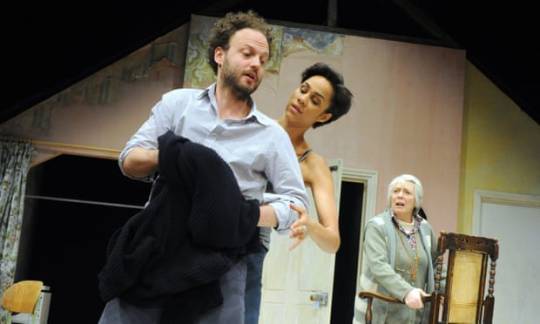
Ashton recounts a story about a black boy being sent home from an audition, having been told that he could never be the Milky Bar kid. Scher, who did the teaching herself, dedicated an entire session to discussing with her pupils where the casting people had done wrong. “We were armed with all of this amazing… activism, I suppose. She’s an amazing woman. You were always encouraged to know why you wanted to act. Politics is not something you think about as a kid, but I realise now that she was infusing us with a level of conscience. You had to be on time, you had to be present. The number of birthdays I missed. I just gave up every Friday night and Saturday afternoon for 14 years.”
It was a dedication that didn’t make her popular with other children at school. Ashton was bullied, and eventually moved secondary school when the threats of beatings from other teenage girls, who knew she was taking days off to film for TV, became too much. At City and Islington College, she found better friends who shared her love of poetry. She took A-levels and applied to do drama at Manchester Metropolitan University.
Then came results day. “I got hurried by my teachers into an antechamber. They were like, ‘Have you opened your results yet?’ I was like, ‘No? Should I? Oh my God, I’ve got three As.’ I was overwhelmed, because it had been a really tough year. My mum had been really ill with cancer. They all said, you have to take a year off to apply to Cambridge now. So there was this crossroads moment – you know, when you realise your life could go in two really different directions? But then the stupid, stupid girl – no, I’m joking. I’m really glad I did what I did.”
What she did was take a year off to look after her mum, and then went to Manchester Met anyway. The course was a bit of a disappointment, she says, the teachers intent on making Ashton less experimental, disparaging her idea to do things such as walk around the audience trailing a red ribbon behind her. (She pitched the same concept at a local experimental theatre a week later and it came second in a commissioning competition.) But she experienced student life, and the partying that she had missed while being such a focused child. She went to Manchester nightclubs and got into DJing, experiences that would prove valuable when she auditioned for Fresh Meat years later.

Written by Jesse Armstrong and Sam Bain, the duo behind Peep Show, the show is set in the fictional Manchester Medlock University. Vod is a blunt, libidinous raver; tub-thumping and workshy, with a thudding estuary accent and directional hair. She shares a house with a mismatched group of students – Jack Whitehall, “who makes me laugh so much”, plays the posh twit whose family money has bought the house. In one memorable scene she is made to read Salman Rushdie’s Midnight’s Children and tells the class the book makes her feel “like I’ve got this pompous, fat, naked man sitting on my face, and he’s resting his big, overrated bollocks on my airways”.
Ashton auditioned for the part about eight times, and saw so many other actors there, of every type and look, that she realised she could make Vod her own, that she wasn’t being asked to play any kind of trope. I ask if there has been any negative response to the only black character in the group ending up as a drug dealer. “NEVER!! Oh my God, that’s never something that’s come up,” she says, clearly surprised by the question. “And I feel like, she’s not even as extreme as a ‘dealer’. Vod is someone who capitalises on situations, sometimes ones that are really misguided. It all goes really horribly wrong – I think Vod’s got a lot of obstacles this series. I’m quite excited about watching it.”
She might well be watching it alone, however, or certainly without her dad, who isn’t too keen on seeing her shows. She might have developed her sense of humour from her parents (“They are my favourite comedy double act”), as well as her love of language (“My dad is such a brilliant writer”), but he can’t get used to seeing her on screen. He pretends her shows are radio plays, so he can keep his eyes closed. “Actually, I told my dad he should watch the episode with Vod and her mum, and he said, ‘I’d love to.’ Then he came in and I was right in the middle of saying the c-word. And he was like, ‘Might just go and put the kettle on again.’ ”
She recently played another challenging role in Not Safe For Work, a much bleaker Channel 4 comedy by playwright DC Moore, about the jilted generation of thirtysomethings whose job security has disappeared. Ashton plays Katherine, one of a group of civil servants whose jobs are relocated from London to Northampton following public sector cuts, and who has to maintain a steely professional exterior to hide the way she is falling apart inside. Other roles have included a small part in Doctor Who (for a moment, she was the bookies’ first choice to become the first female Doctor), and the lead in Dreams Of A Life, Carol Morley’s documentary film about Joyce Vincent, the woman whose remains were found on her sofa three years after her death, with the television still on.

“I just always play these really extreme characters – they’ve all come with parental guidance stickers on them. I did this Abi Morgan play at the Donmar just now and she said, ‘You play a lot of outsiders, don’t you?’ And I was like, ‘Oh my God, I do!’” She looks surprised. “And she said, ‘Outsiders who don’t need much male intervention.’ ‘Well, yes, I do,’ I said, like I knew that about myself.”
Other theatre work includes Othello at the Globe and Gone Too Far! at the Royal Court, which is the theatre where she took the young writers’ course and wrote her play For All The Women Who Thought They Were Mad, at 24. It was inspired by research into the way that psychiatric medication affects women, and the way that black women in particular are often over-medicated, so that their health deteriorates even further. “There are stories of women in pretty powerful positions, in jobs, suddenly finding themselves in institutions, unrecognisable to themselves and their friends,” she says. “So I just had to sit in the research and think about it, but there was a writing competition. The night before the deadline, I said to myself, you really owe it to yourself to deliver – just do it. So I sat down and wrote it in an actual fever, staying up for 24 hours.”
Next up is the Genet play The Maids, a double-hander with Emmy-winning American actor Uzo Aduba (best known as Crazy Eyes in Orange Is The New Black), opening in London next month. “It’s going to be really, really interesting to explore two characters who are essentially ready to burst from the beginning of the play.”
After that, perhaps she will have time for a quick personal collapse, though it seems unlikely. “I don’t really have the luxury of having a breakdown,” Ashton says. “I’ve just been working for a really, really long time.” And yet that 200-year-old woman in the corridor has got another century ahead of her, at least.
13 notes
·
View notes
Text
The album title "Ptah, The El Daoud" refers to the ancient Egyptian deity Ptah, who was believed to be the creator of the universe, and "El Daoud," which is Arabic for "the beloved."
The song title "Turiya & Ramakrishna" is named after two spiritual figures from India: Turiya, a Sanskrit word meaning "the fourth state of consciousness," and Ramakrishna, a 19th-century Indian mystic and saint.
(The fourth state of consciousness is sometimes translated as "pure consciousness." It is considered to be the source of all other states of consciousness and the underlying ground of all existence. In Turiya, the individual self (or ego) is said to be dissolved, and the individual becomes aware of their true nature as pure consciousness. It is described as a state of profound peace, bliss, and spiritual realization.)
"Turiya & Ramakrishna" features Alice Coltrane on harp and piano, Joe Henderson on tenor saxophone, and Ron Carter on bass. The track has been praised for its beautiful melody and improvisation, as well as its spiritual depth and exploration. It has since become a jazz standard and a signature piece of Alice Coltrane's body of work.
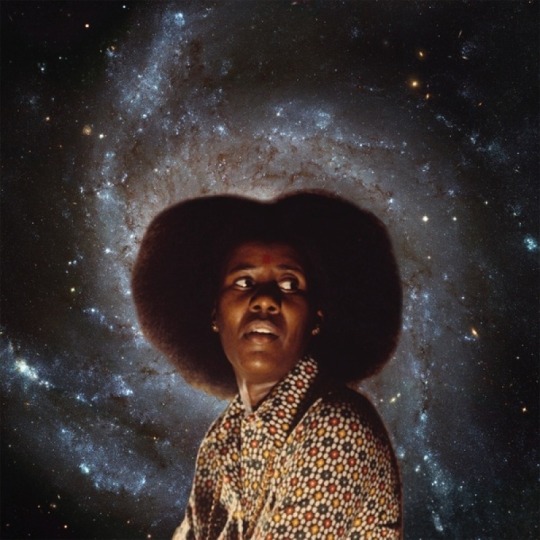
Alice Coltrane (1937-2007) is famous for her contributions to jazz music as a pianist, organist, harpist, and composer. She was a key figure in the development of spiritual jazz, a subgenre of jazz music that emphasizes spiritual and meditative qualities, and incorporated elements of Indian classical music into her compositions.
She married the legendary saxophonist John Coltrane in 1965, and played piano and harp on some of his later albums, including "Ascension" and "Meditations". After John Coltrane's death in 1967, Alice Coltrane began to explore her own musical vision, incorporating elements of Indian classical music, African music, and gospel music into her compositions.
In addition to her musical achievements, Alice Coltrane was also known for her spiritual pursuits. She became a devotee of the Indian guru Sathya Sai Baba and founded the Vedantic Center, a spiritual community in California. She also established the Sai Anantam Ashram in Agoura Hills, California, where she lived and recorded until her death in 2007.
Alice Coltrane's innovative approach to jazz music, her incorporation of diverse musical traditions, and her spiritual pursuits have made her a revered figure in the jazz world and beyond.
(Satchidananda refers to Sri Swami Satchidananda, an Indian guru who gained fame in the West for his teachings on yoga and spirituality.)
13 notes
·
View notes
Text
(1)
قَيِّدُوا الْعِلْمَ بِالْكِتَابِ
“Ikatlah (catatlah) ilmu dengan tulisan.” (HR. Ibnu ‘Abdil Barr)
Tulisan pertama di 30 hari ini yang seharusnya terposting kemarin.
Nama adalah doa. Barangkali kita sudah mendengar tentang ungkapan ini, dan sebab itulah jika ada yang bertanya mengapa akhirnya aku memutuskan mengikuti challenge #30haribercerita ini.
Orang tuaku memberiku nama pertama yang begitu spesifik "Mushonnifun", diambil dari bahasa arab 'مُصَنِّفٌ' , yang jika diartikan adalah penulis.
Barangkali aku masih belum memenuhi ekspektasi mereka, dengan usia yang sebentar lagi menginjak kepala 3 ini, seharusnya sudah banyak karya-karya tulisan yang lahir, namun hingga hari ini mungkin masih jauh dari kata banyak, berkualitas, apalagi bermanfaat.
Enam belas tahun terakhir semenjak tahun 2007, aku masih ingat saat mulai aktif menulis di media sosial. Dari jamannya Multiply, Blogspot, Website, Facebook Notes, Wordpress, hingga terakhir menggunakan tumblr, dan mungkin jejak digital itu bisa membuktikannya. Namun entah diri ini merasa 3 tahun terakhir, justru pasca melahirkan 2 karya di tahun 2020, keistiqomahan ini justru menurun. Entah yang tak meluangkan waktu, atau terlalu sibuk dengan pekerjaan, ah aku tak mau excuse dengan itu karena sesungguhnya aku yang seharusnya meluangkan waktu.
Hingga mungkin keputusanku saat ini menjadi seorang pendidik tak lepas dari manifestasi doa yang dilangitkan orang tuaku melalui namaku, karena dengan profesi ini akan menuntutku untuk menulis, walau 3 tahun terakhir ternyata tulisan yang tak kalah banyak adalah tulisan berbau administrasi dan borang akreditasi #eh #hehehhe.
Awal tahun ini mencoba merenung, barangkali makna penulis di sini adalah dimulai dari hal-hal kecil. Sesederhana mencatat ketika guru/dosen menerangkan, mencatat ketika ustadz atau guru ngaji memberikan nasihat dan kalam-kalam mulia. Yang ketika mencoba merefleksi hal-hal kecil seperti ini seringkali masih kuremehkan. Padahal selalu digaung-gaungkan oleh guruku bahwasanya salah satu adab dalam mencari ilmu adalah dengan mencatatnya.....
#30haribercerita #30hbc2401
instagram
4 notes
·
View notes
Text
On seeing Che Guevara’s mural, Balvir Singh’s neighbours asked whether he had painted a ghost in their village.
Mander Kaur, Singh’s next-door neighbour said, “To tell you the truth, my kids wanted Balvir to paint over the mural. They were convinced that Che was a bhoot (ghost) because of his long flowing hair..they were scared to leave the house.”
Expecting such a reaction, Singh explained to them how, like Bhagat Singh, Guevara was also a revolutionary socialist. He then pointed to Lenin’s mural and said that his ideas were particularly inspirational for Bhagat Singh. “I told them how Lenin was one of Bhagat Singh’s Gurus, after which they stopped pestering me to get rid of the murals,” said Balvir Singh.
Gursewak Singh, a professor who also resides in Bhai Desa village, said, “This is a time when our youth needs to be reminded of what Bhagat Singh and these revolutionaries believed in. And because of Balvir’s paintings, there has certainly been some interest in learning about samajwad (socialism) and kranti (revolution).”
Although Balvir Singh otherwise runs a flex business store in the nearby city of Maur Mandi, the recent lockdown left him without any work and he decided to keep himself busy by painting the walls of his village, Bhai Desa. He painted images and quotes about a host of topics like saving water and reducing plastic usage but the ones that particularly stood out were the murals of such popular leftist figures.
“I’ve read the writings of all these icons, and ultimately what’s in my head and heart is what will come out of my hand too, right?” said Balvir Singh. He said he has been a lifelong follower of Bhagat Singh and is also a communist and thus couldn’t hide his admiration for these revolutionaries. Unlike his other work that is spread all over the village, these murals are painted on the walls of Singh’s own home.
Singh, now 40, began reading Bhagat Singh’s writings at the age of 16, around the same time that his father died unexpectedly and he had to drop out of school to support his family. A few years later, he got involved with a movement against unemployment led by the All India Youth Federation (AIYF), the youth wing of the CPI. While he never became an official party member, he diligently involved himself in the party’s activities, which ranged from speeches to protests and demonstrations.
“No one in my friend circle became official members of the party, but we were involved in the movement. We would go among the people and talk about employment, about our deteriorating conditions. We used to fill up buses and go to protests,” said Balvir Singh.
Specifically, he helped organise yearly demonstrations on Bhagat Singh’s birthday on September 28. “In 2007, on Bhagat Singh’s centenary, I painted his photos all over Punjab. I want the people of Punjab to remember Bhagat Singh. Just like we celebrate Holi and Diwali as major festivals, we should also be celebrating Bhagat Singh’s birthday,” said Balvir Singh.
Even though Bhagat Singh remains a beloved figure in the region, his ideas of socialism and revolution don’t garner the appeal they once did here. Jagtar Singh, a Punjabi Tribune journalist who was also involved with the AIYF agitation in the late 90s, said “There was a time when Communists were very popular in the state. In fact, they had a stronghold in Mansa (the district that Bhai Desa village is situated in). But right now, they’re struggling to maintain their very existence.”
In 1977, CPI and CPI(M) had a total of 15 seats in the state assembly, testifying to their support. The state has also produced firebrand leftist leaders like Harkishan Singh Surjeet, who served as the General Secretary of the CPI(M) from 1992 to 2005, and Satyapal Dang, who represented the CPI in the state legislative assembly for four terms. Additionally, the Naxalite movement also took root in the state, and influenced prominent writers and artists like Paash, Laal Singh Dil and Gursharan Singh.
Anand Patwardhan’s documentary, In Memory of Friends or ‘Una Mitran Di Yaad Pyaari’, set in the late 80s when the Khalistani movement that demanded a separate homeland for Sikhs was at its peak, showed how communists played a prominent role in fighting communal violence against Hindus as well as state violence against Sikhs. Some party activists like Jaimal Singh Padda even lost their lives at the hands of Khalistani militants. Since then, however, they have declined There are no active MLAs from left parties and the Naxalite movement has also virtually disappeared from the region.
There are several reasons for this decline, with the first being increasing factionalism in the left. “By 2002, the CPM had split into CPM and CPM (Punjab), which affected its electoral fortunes rather badly.” writes Professor Chaman Lal, a retired JNU professor.
In an interview with The Wire, Lal added, “Even now left-leaning groups like Bharat Kisan Union have some hold among the peasant working class of Punjab. But the problem again is that these groups are also divided into factions. Moreover, these radical organisations often opt to stay out of parliamentary politics, and instead they participate in mass resistance only for minor reliefs like financial support for farmers and so on.”
Others attribute the Left’s present absence to its perceived image as a foreign movement that was vehemently opposed to religion. Bhupinder Singh Mann, a Mansa-based author and educator, said, “Words like proletariat and bourgeois have had a negative impact on left politics. People perceived communism as a movement from elsewhere and didn’t want to join it for that reason.” He added, “They thought that Communists stand for ‘qaum nasht’ (‘community destruction’), and that they will destroy the Sikh qaum.”
According to Sukhdarshan Singh Natt, a Mansa-based senior leader of the CPI(ML) Liberation, “Part of the reason for the Left’s decline in Punjab is that older parties like the CPI actually supported the Emergency instituted by Indira Gandhi, hence maligning the image of all leftists in Punjab.” Jaspal Singh Sidhu, a Chandigarh based writer, argues that the political positions of prominent leftist parties did not differ from “bourgeois” parties like the Congress and the BJP in that they all reinforced the idea of the Indian nation-state.
This does not mean that the ideology has totally vanished. Every year in November, various progressive thinkers and leaders congregate at the ‘Mela Ghadari Babeiyan Da’ (‘Fair of Ghadar Veterans’), held at the Desh Bhagat Yadgaar Hall in Jalandhar, Punjab. The programme consists of talks, discussions and performances of revolutionary songs and poetry by renowned artists. Progressive literature, translated into Punjabi, is sold at at affordable prices.
Balvir Singh visits the mela each year with his comrades, including journalist Jagtar Singh, and returns home with a pile of literature and books. It was through the ‘Mela Ghadari Babeiyan Da’ that he learned about Che Guevara and Lenin and what they stood for. He has their framed photos and quotes hung up all over the walls of his office, alongside Bhagat Singh’s.
Students politics at Punjab University present a ray of hope for the Left in the state. In 2018, 22-year old Kanupriya of the left-leaning SFS (Students for Society) made history by becoming the first woman president of Punjab University. She won on the platform of opposing fee hikes, increasing commercialisation of education and deteriorating conditions of hostel and mess workers.
CPIML’s Sukhdarshan Singh Natt said that stories like Kanupriya’s keep him and others motivated to continue doing their work. He said, “Punjab University elections are similar to elections in the state in that votes are bought with money. But, SFS won the elections based on its manifesto and on ground work. While University elections don’t have a lot of impact on the ground, it’s heartening to know that it’s possible to influence people and win on the basis of integrity.”
According to Professor Lal, the present time is quite ripe for a resurgence of the left, but that can only happen if leftists are able to form a joint front and oppose fascist forces. He said, “The coronavirus pandemic has exposed the Indian class situation to the crudest level – the whole facade and illusion of a welfare state has been completely exposed. The Left movement can make an impact if it has organisational strength and a clear view of how to organise the most oppressed unorganised working class”.
24 notes
·
View notes
Text
Prayer for World Peace and Welfare
Prayer for World Peace and Welfare
The three jewels and three roots,
Trustworthy source of refuge, and in particular the lord of snow,
Avalokiteśhvara, Jetsün Tara and Guru Padmasambhava, I supplicate you; please follow your previous pledges!
Bestow blessings that this aspiration prayer may be fulfilled most perfectly!
Due to the degeneration of times when thoughts and deeds of beings are perverted and the inner and outer elements have lost their balance, men and cattle are seized by epidemic disease previously unheard of;
Intruding rāhus, nāgas, powerful demons and dark forces, blight, frost and hail, bad harvest warfare and so forth,
Erratic rainfall, heat, misery and droughts in the world, destruction by the elements such as earthquakes and the threat of fire,
And in particular barbaric offenses causing harm to the teachings are rampant.
May all types of harm and injury around the world be swiftly pacified and overcome!
May precious and supreme Bodhicitta spontaneously arise in the mindstreams of all beings, human and non-human, and may they be free from destructive thoughts and deeds!
May all be endowed with a loving mind for one another and may well-being, glory and prosperity prevail throughout the world! May the Buddha’s teachings spread far and wide and ever last!
By the truthful power of the three roots, the Buddhas and Bodhisattvas, by any root of virtue existing in samsara and nirvana and by the power of our perfectly pure, highest intention, may the fruition of our supplication and aspiration be attained!
This prayer was composed by Jamgön Kongtrül Rinpoche for the peace and welfare of Tibet. In order to suit present times, Lama Thubten Nima changed certain wording, such as the reference to the whole world instead of only to Tibet.
Translated by Ina Bieler in December 2007, Copyright © The Garchen Institute 2007. All rights reserved.
4 notes
·
View notes
Text
Delving into the Sinister: A Timeline of the “Saw” Horror Saga

by @ablufox:
The “Saw” franchise, debuting in 2004 with James Wan’s pioneering installment, has left an indelible mark on the horror genre, weaving a tale of morbid curiosity, justice, and relentless terror. This saga has stretched over nearly two decades, amassing a cult following and influencing a generation of horror lovers. With the release of “Saw X,” it’s a fitting moment to trace the bloody legacy of the “Saw” series, shedding light on its narrative evolution and the grotesque allure of Jigsaw’s moral games.
“Saw” (2004):
“Saw” emerged as a fresh, disturbing narrative in the horror genre, conceptualized by James Wan and Leigh Whannell. The film introduced audiences to the Jigsaw Killer (or Jigsaw), a terminally ill cancer patient turned moralistic serial killer who puts his victims in gruesome, life-threatening traps to test their will to live and moral compass. The notorious bathroom trap, where two men find themselves chained in a grimy, decrepit bathroom with a corpse, sets a precedent for the eerie, claustrophobic atmosphere and complex, horrifying traps that would become the franchise’s trademark.
“Saw II” (2005):
Directed by Darren Lynn Bousman, “Saw II” builds on the terror from the first film, delving deeper into Jigsaw’s twisted ideology. The film introduces a group of eight individuals trapped in a house filled with deadly traps while Detective Eric Matthews attempts to save his son, who is among the trapped. The narrative explores the fallout of personal and professional wrongdoings as the characters face the consequences of their actions through Jigsaw’s gruesome tests.
“Saw III” (2006):
In “Saw III,” the narrative becomes more emotionally charged, exploring the mentor-apprentice relationship between Jigsaw and Amanda Young. Directed again by Bousman, the film showcases Jigsaw’s final test for Amanda, along with another game set for a grieving father seeking revenge for the loss of his son. The intricate relationships and emotional turmoil add depth to the characters and explore the theme of forgiveness amidst a backdrop of escalating brutality and complex traps.
“Saw IV” (2007):
“Saw IV” unveils the backstory of Jigsaw, delving into his transformation from John Kramer, a grieving husband and future father, to the sadistic mastermind Jigsaw. Directed by Bousman once again, the film intertwines with events from previous installments, showcasing a complex narrative that enriches the franchise’s lore. The narrative explores themes of loss, grief, and the blurred lines between justice and revenge.
“Saw V” (2008):
Directed by David Hackl, “Saw V” delves into the aftermath of Jigsaw’s death, focusing on the power struggle between his apprentices. The film explores the challenges Detective Mark Hoffman faces as he attempts to continue Jigsaw’s legacy while evading the suspicions of his colleagues. The narrative also explores the theme of trust as five individuals are put through a collaborative game where teamwork is crucial for survival.
“Saw VI” (2009):
Directed by Kevin Greutert, “Saw VI” takes a more societal approach, exploring healthcare and corporate greed themes through a game set for an insurance executive. The film highlights the consequences of bureaucratic decisions on individual lives, blending real-world fears with the franchise’s signature gore and moral quandaries. The narrative also continues to unravel the intricacies of Jigsaw’s posthumous influence.
“Saw 3D: The Final Chapter” (2010):
Marketed as the concluding chapter, “Saw 3D,” directed by Greutert, aims to tie up loose ends in the franchise. The film amps up the gore and introduces a self-help guru who falsely claims to be a Jigsaw survivor. As his deceit unravels, a deadly game ensues, intertwining with the overarching narrative of Jigsaw’s legacy and its struggle for control.
“Jigsaw” (2017):
After a seven-year hiatus, directors Michael and Peter Spierig revived the franchise with “Jigsaw.” The film explores new facets of Jigsaw’s ideology, introducing a fresh set of characters entangled in a deadly game while uncovering undisclosed aspects of Jigsaw’s past. The narrative attempts to bridge the gap between old and new, tying back to the franchise’s origins while presenting a new mystery to unravel.
“Spiral: From the Book of Saw” (2021):
Directed by Bousman, “Spiral” veers slightly from the established formula, exploring a new narrative arc with Detective Ezekiel “Zeke” Banks, played by Chris Rock, investigating gruesome murders reminiscent of Jigsaw’s games. The film examines systemic corruption within the police department, serving as a commentary on real-world issues while paying homage to the franchise’s legacy.
“Saw X” (2023):
The latest installment, “Saw X,” dives deeper into the dark lore of the franchise, unearthing past connections and presenting a new level of moral decay. The film reinvigorates the franchise with its intricate narrative and bone-chilling scares, hinting at more terror-laden puzzles awaiting in the shadows. As a reminder, “Saw X” occurs between the original and its first sequel, “Saw II.”
The “Saw” franchise has etched itself into the horror genre’s hall of fame through its relentless exploration of morality amidst a backdrop of ghastly terror. With its unique narrative angle and gruesome ingenuity, each installment invites audiences into a dark, reflective journey through the macabre tapestry of human fear and retribution. The legacy of Jigsaw’s twisted games continues to resonate, ensuring the “Saw” saga a gruesome yet captivating place in the annals of horror cinema.
#saw movie#saw franchise#john kramer#saw 2004#saw 2#saw 3#saw 4#saw 5#saw v#saw vi#saw 3d#jigsaw#spiral from the book of saw#saw ii#saw iii#saw iv#saw x#horror
4 notes
·
View notes
Text
august 2022
*favorite
black narcissus (1947, dir. michael powell & emeric pressburger)
casque d’or (1952, dir. jacques becker)
isabella (2020, dir. matías piñeiro)
pink narcissus (1971, dir. james bidgood)
la haine (1995, dir. mathieu kassovitz)
lumière d'été (1943, dir. jean grémillon)
black orpheus (1959, dir. marcel camus)
stromboli (1950, dir. roberto rossellini)
the night of counting the years (1969, dir. shadi abdel salam)
buud yam (1997, dir. gaston kaboré)*
daughters of the sun (2000, dir. maryam shahriar)
pyaasa (1957, dir. guru dutt)
the arch (1968, dir. shu shuen)
visitor of a museum (1989, dir. konstantin lopushansky)
the elephant man (1980, dir. david lynch)
ran (1985, dir. akira kurosawa)*
koyaanisqatsi (1982, dir. godfrey reggio)
the halt (2019, dir. lav diaz)
family nest (1979, dir. béla tarr)
the outsider (1981, dir. béla tarr)
the prefab people (1982, dir. béla tarr)
almanac of the fall (1984, dir. béla tarr)
werckmeister harmonies (2000, dir. béla tarr & ágnes hranitzky)*
the man from london (2007, dir. béla tarr & ágnes hranitzky)
everything everywhere all at once (2022, dir. daniel kwan & daniel scheinert)
stalker (1979, dir. andrei tarkovsky)*
sátántangó (1994, dir. béla tarr)*
---
finally galaxy-brained enough to watch all of satantango
27 notes
·
View notes